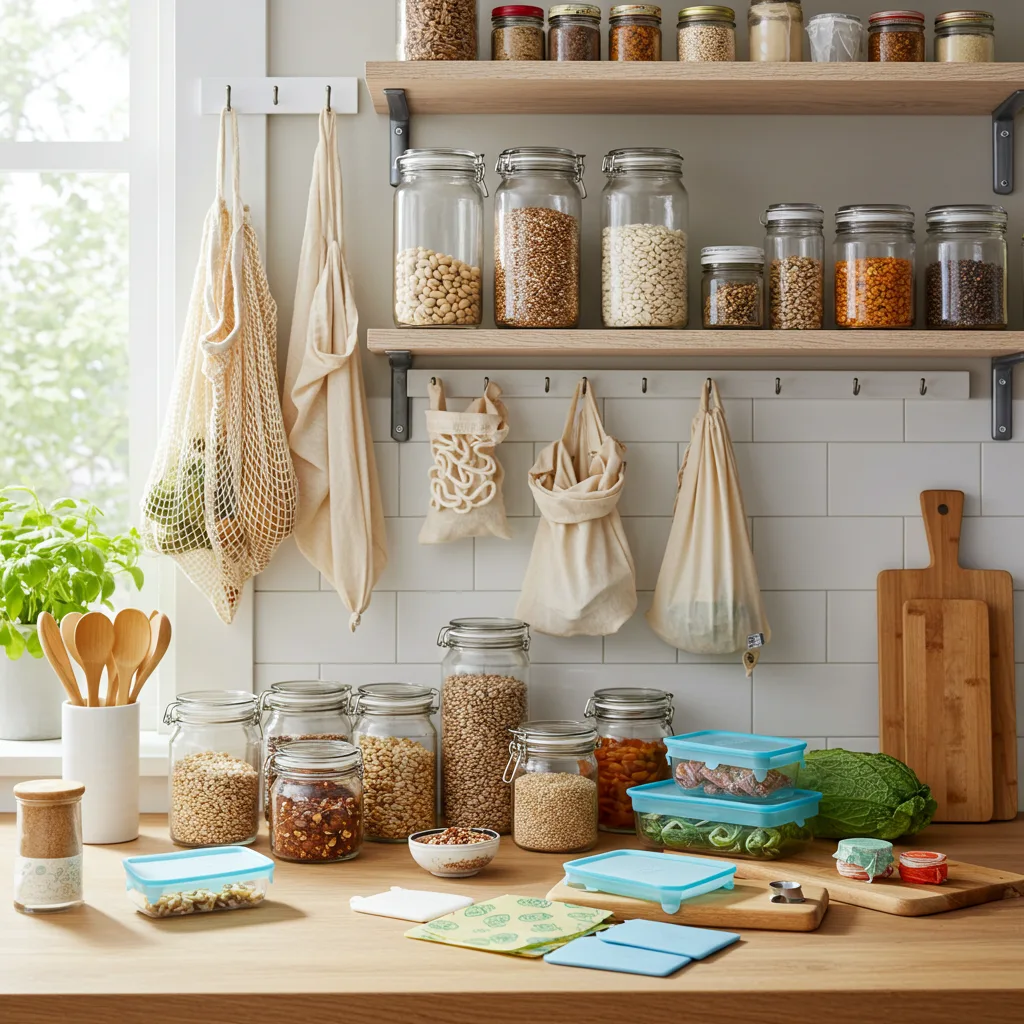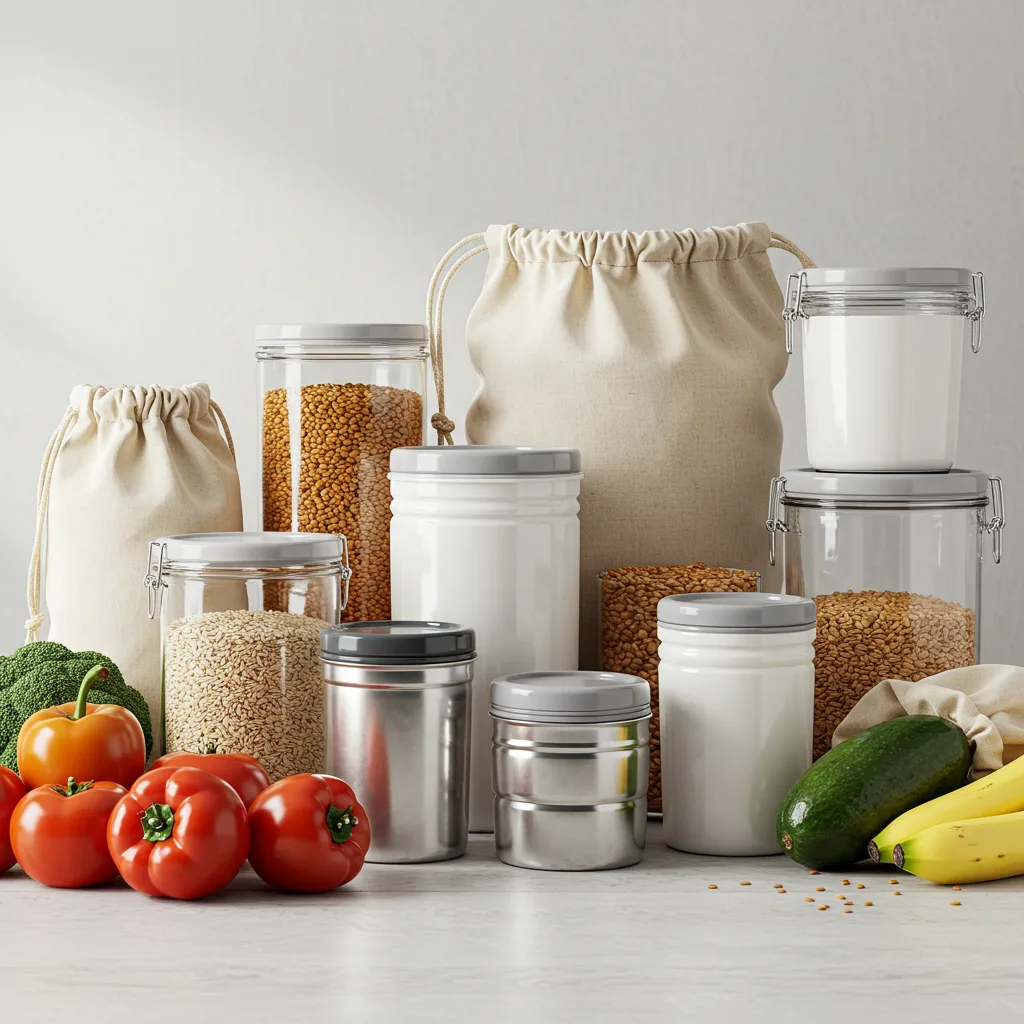15 Zero-Waste Kitchen Solutions That Save Money and the Planet
The kitchen is often the heart of the home—and unfortunately, it’s also where we generate the most waste. From food scraps and packaging to cleaning products and disposable items, the average kitchen produces hundreds of pounds of waste each year. As an EcoDweller who’s been on a journey toward sustainable living, I’ve discovered that reducing kitchen waste isn’t just good for the planet—it’s also great for your wallet! In this guide, I’ll share 15 practical zero-waste kitchen solutions that help you save money while reducing your environmental impact.
Why Zero-Waste Kitchen Matters
According to the Environmental Protection Agency (EPA), food waste alone makes up about 24% of what goes into landfills. When food and other kitchen waste decompose in landfills, they produce methane—a greenhouse gas 25 times more potent than carbon dioxide. By implementing zero-waste kitchen solutions, you’ll not only reduce your carbon footprint but also discover cost savings on groceries, cleaning supplies, and everyday essentials. These solutions complement the strategies I shared in my kitchen waste reduction guide and expand on my zero waste for beginners article.

Composting is the cornerstone of a zero-waste kitchen. Even apartment dwellers can compost food scraps with compact systems. I use a countertop compost bin with a charcoal filter to collect scraps throughout the week, then transfer them to my outdoor compost bin. If you live in an apartment, services like ShareWaste connect you with local gardeners who will take your compost, or you can investigate city composting programs. This simple practice has dramatically reduced my trash output while creating nutrient-rich soil for my garden, as I discussed in my backyard composting guide.
(Bamboozle Compost Bin available on Amazon affiliate link, marked as nofollow)
- Reduces garbage bag usage by 25-30%, saving $30-50/year
- Creates free garden fertilizer worth $40-100/year
- One EcoDweller reader cut her trash service in half, saving $156/year
Free Tools: Repurposed container with lid
Paid Tools: Countertop compost bin ($15-40), outdoor compost bin ($50-120) or worm bin ($50-100)
Ditch plastic wrap, aluminum foil, and disposable bags for sustainable alternatives. I’ve replaced these with beeswax wraps, silicone lids, and glass containers with bamboo lids. These reusable options not only eliminate daily waste but also keep food fresher longer. My favorite beeswax wraps have lasted over a year with proper care, far outlasting countless rolls of plastic wrap I would have used. This aligns with the sustainable products I recommended in my eco-friendly products guide.
(Beeswax Food Wraps available on Amazon affiliate link, marked as nofollow)
- Eliminates need for plastic wrap, saving $30-50/year
- Glass containers extend food freshness by 3-5 days, reducing food waste by up to 20%
- My household saved approximately $215 last year by reducing food spoilage
Free Tools: Repurposed glass jars
Paid Tools: Beeswax wraps ($15-25), silicone food covers ($10-20), glass containers ($30-60 for a set)
Commercial cleaning products come in plastic bottles that end up in landfills. I’ve switched to making simple, effective cleaners from ingredients like vinegar, baking soda, and castile soap. I store these in glass spray bottles and pair them with washable cleaning cloths instead of paper towels. My all-purpose cleaner costs mere pennies per bottle compared to $4-5 for store-bought versions, and it works just as well without the harsh chemicals, complementing the sustainable living approach I discussed in my sustainable living guide.
(Glass Spray Bottles available on Amazon affiliate link, marked as nofollow)
- Homemade cleaners cost $0.50-1.00 per bottle vs. $4-7 for commercial products
- Reusable cleaning cloths save $60-100/year compared to paper towel use
- One EcoDweller reader calculated saving $237/year after switching to homemade cleaning products
Free Tools: Repurposed spray bottles, old t-shirts cut into rags
Paid Tools: Glass spray bottles ($10-20 for set), microfiber cloths ($10-15), ingredients like vinegar, baking soda, castile soap ($15-20)
Single-use plastic water bottles create enormous waste—Americans use about 50 billion plastic water bottles annually, with only about 20% being recycled. I installed a simple faucet-mounted water filter instead of buying bottled water. Paired with reusable water bottles, this system has eliminated hundreds of plastic bottles from my household waste while providing clean, great-tasting water. The filter needs replacement just a few times per year, creating minimal waste compared to daily bottled water. This approach builds on the waste reduction strategies I shared in my eco-dweller beginner tips.
(Brita Faucet Water Filter System available on Amazon affiliate link, marked as nofollow)
- Eliminates cost of bottled water, saving $300-600/year for a family of four
- Filter replacement costs $30-60/year vs. $365+ for daily bottled water
- My household saved $482 last year compared to our previous bottled water consumption
Free Tools: Existing reusable water bottles
Paid Tools: Faucet-mounted filter ($25-35), pitcher filter ($20-40), replacement filters ($30-60/year)
The average American family wastes about 25% of the food they purchase, costing $1,500+ per year. I’ve dramatically reduced my food waste by implementing a simple meal planning system. Each weekend, I inventory my pantry and refrigerator, plan meals that use what I already have, and create a shopping list for only what I need. I also designate one day per week as “leftovers day” to ensure nothing gets forgotten. This approach has cut my grocery bill significantly while reducing food waste, supporting the principles I outlined in my cut kitchen waste article.

- Reduces grocery spending by 20-25%, saving $2,000-3,000/year for a family of four
- Minimizes impulse purchases, saving an additional $500-1,000/year
- One EcoDweller reader reported saving $257/month after implementing meal planning
Free Tools: Printable meal planning templates, inventory sheets (available online)
Paid Tools: Meal planning apps ($0-5/month), magnetic meal planning board ($15-30)
Paper towels, napkins, and other disposable paper products create ongoing waste and expense. I’ve switched to cloth napkins, washable kitchen towels, and reusable “unpaper” towels for most cleaning needs. These cloth alternatives are not only more environmentally friendly but also more effective for many cleaning tasks. I wash them with my regular laundry, so there’s minimal additional water or energy use. This simple switch complements the sustainable practices I discussed in my sustainable apartment living guide.
(Organic Cotton Unpaper Towels available on Amazon affiliate link, marked as nofollow)
- Eliminates paper towel purchases, saving $75-150/year
- Cloth napkins save $30-60/year compared to paper napkins
- Initial investment of $40-80 pays for itself within 6-8 months
Free Tools: Repurposed t-shirts and towels cut into cleaning cloths
Paid Tools: Cloth napkins ($15-30/set), unpaper towels ($20-40/set), napkin holder ($10-15)
Compare Zero-Waste Kitchen Solutions
| Zero-Waste Solution | Initial Investment | Annual Savings | Environmental Impact |
|---|---|---|---|
| Composting System | $15-120 | $70-150 | High – Diverts 200-400 lbs waste/year |
| Reusable Food Storage | $40-100 | $150-250 | High – Eliminates plastic waste |
| DIY Cleaning Kit | $25-50 | $150-240 | High – Reduces plastic & chemicals |
| Water Filter System | $25-40 | $270-540 | High – Eliminates plastic bottles |
| Meal Planning | $0-30 | $1,500-3,000 | Very High – Reduces food waste |
| Cloth Alternatives | $40-80 | $105-210 | Medium – Reduces paper waste |
| Bulk Shopping | $30-70 | $200-400 | High – Reduces packaging waste |
| Reusable Produce Bags | $10-25 | $20-40 | Medium – Eliminates plastic bags |
Note: Savings will vary based on household size, consumption patterns, and local costs. The figures above represent average U.S. households.
Free vs. Paid Zero-Waste Kitchen Tools: Which Should You Use?
| Kitchen Need | Best Free Option | Best Paid Option |
|---|---|---|
| Food Storage | Repurposed glass jars | Beeswax wraps ($15-25) |
| Cleaning | T-shirt rags | Organic cotton cloths ($15-20) |
| Composting | DIY bin from bucket | Countertop compost bin ($30) |
| Shopping | Reused paper bags | Organic cotton totes ($20-30) |
| Food Prep | Existing containers | Stainless steel containers ($25-40) |
Rule of thumb: Start with free options using what you already have, then gradually upgrade to durable, high-quality paid options as they’re needed.
Packaging waste makes up a significant portion of household trash. I now bring my own containers to bulk food stores for pantry staples like rice, beans, flour, nuts, and spices. Many stores will tare (pre-weigh) your containers so you only pay for the product. Besides eliminating packaging waste, buying in bulk typically costs 30-50% less than packaged equivalents. I’ve found that mason jars and cloth bags work perfectly for this purpose. This practice builds on the zero-waste strategies I outlined in my zero waste for beginners guide.

- Bulk foods cost 30-50% less than packaged equivalents, saving $200-400/year
- Eliminates need for additional food storage containers at home
- My pantry staples spending decreased by $267 last year after switching to bulk buying
Those flimsy plastic produce bags at grocery stores are used for minutes but last for centuries in landfills. I bring washable mesh produce bags for fruits and vegetables instead. They’re lightweight, breathable, and allow cashiers to see what’s inside for easy checkout. Many stores now offer a small discount for bringing your own bags, which adds up over time. This simple swap complements my sustainable shopping habits discussed in my sustainable living guide.
(Reusable Produce Bags available on Amazon affiliate link, marked as nofollow)
- Set of 8-12 bags costs $10-25 but lasts for years
- Many stores offer $0.05-0.10 discount per bag used
- Proper produce storage extends freshness, reducing food waste by up to 10%
Store-bought herbs come in plastic packaging and often spoil before you can use them completely. I maintain a small windowsill herb garden with basil, mint, cilantro, and chives, providing fresh herbs whenever I need them. This eliminates packaging waste while providing fresher, more flavorful ingredients. Even apartment dwellers can grow herbs in small pots or vertical gardens. This practice enhances the sustainability concepts I shared in my EcoDwellers guide.
(Indoor Herb Garden Kit available on Amazon affiliate link, marked as nofollow)
- Eliminates need for store-bought herbs, saving $5-10 per shopping trip
- Annual savings of $100-250 for frequent herb users
- One EcoDweller reader calculated saving $178 in one year with a simple herb garden
Commercial plant milks come in cartons that are often difficult to recycle. I now make my own almond, oat, and cashew milks using a simple blender and strainer. The process takes just minutes and creates milk that’s fresher and free from preservatives and additives. The leftover pulp can be used in baking or added to smoothies, creating zero waste. This complements the plant-based approaches I mentioned in my beginner eco tips.
(Nut Milk Bag available on Amazon affiliate link, marked as nofollow)
- Homemade plant milk costs $0.50-1.50 per quart vs. $3-5 for store-bought
- Annual savings of $125-350 for regular plant milk consumers
- My household saved $247 last year making our own oat and almond milks
Before sending food scraps to compost, many can be repurposed. I keep a container in my freezer for vegetable ends and peels to make stock, regrow green onions in water, turn stale bread into croutons, and blend wilting herbs with oil to make cubes for future cooking. These practices extract maximum value from food before composting the truly inedible parts. This approach builds on the waste reduction strategies in my kitchen waste article.

- Homemade vegetable stock saves $3-5 per quart compared to store-bought
- Regrowing vegetables from scraps saves $50-100/year
- Repurposing leftovers reduces food waste by 15-25%, saving $300-500/year
Conventional dish cleaning involves plastic sponges, brushes, and bottles of detergent. I’ve switched to compostable dish brushes made from bamboo and natural fibers, solid dish soap bars, and wooden dish racks. These tools clean just as effectively without creating microplastic waste or leaving behind plastic bottles. This approach aligns with the sustainable product recommendations in my eco-friendly products guide.
(Bamboo Dish Brush Set available on Amazon affiliate link, marked as nofollow)
- Dish soap bars last 2-3 times longer than liquid soap, saving $20-40/year
- Natural fiber brushes last 6-12 months vs. 2-4 weeks for plastic sponges
- Annual savings of $30-75 on dish cleaning supplies
Learning basic food preservation techniques like freezing, pickling, and dehydrating helps extend the life of seasonal produce and reduces waste. I freeze berries when they’re in season, pickle excess vegetables from my garden, and dehydrate fruits for snacks. These preserved foods last months and help reduce dependency on store-bought packaged alternatives. This skill builds on the sustainability practices I discussed in my sustainable living guide.
- Preserving seasonal produce at peak ripeness saves 40-60% compared to off-season prices
- Reduces food waste by 20-30%, saving $400-700/year
- Homemade preserves cost $1-3 per jar vs. $5-8 for artisanal versions
The kitchen uses significant amounts of water that can often be reused. I place a basin in my sink to collect water used for rinsing fruits and vegetables, then use it to water plants. I also collect the water that runs while waiting for hot water and save pasta cooking water (once cooled) for plants, as it contains nutrients. These simple habits save gallons of water daily and reduce utility bills. This approach enhances the conservation strategies I shared in my EcoDwellers guide.
- Can save 5-10 gallons of water daily in an average household
- Reduces water bill by $30-75/year depending on local rates
- Collected water contains nutrients that benefit plants, reducing need for fertilizers
Designate a specific container or area in your refrigerator for food that needs to be used soon. This visual reminder helps prevent food from being forgotten and eventually wasted. I use a clear bin labeled “Eat Me First” that stays at eye level in my refrigerator. This simple organizational trick has dramatically reduced my food waste and saved money on groceries. This practice complements the food waste reduction strategies

